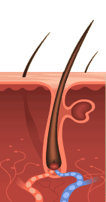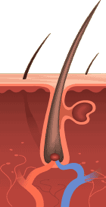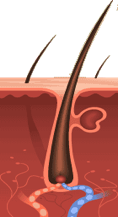

A human being has 100.000 to 150.000 hairs. De hair growth cycle goes as follows:

The anagen phase, the hair grows (3-6 years) and becomes thicker and longer. About 85% of the hair is in this phase. If this is less than 85%, then it is called increased hair loss.

The catagen phase, the hair growth stops and the hair starts to loosen from the hair root (duration 2-3 weeks). About 1-2% of the hair is in this phase.

The telogen phase, The old hair follicle is being pushed out, the new hair will grow after 2-3 months, About 10-15% of the hair is in this phase.
The hair
Each hair has 3 layers. The inner layer is called the medulla and consists of soft keratin. The middle layer is a fibrous keratin layer, called cortex. The outer layer is the hair shaft. That is the most stable and consists of hard keratin scales that form a good coating.
Just under the skin is a special hair follicle where keratin cells are produced, who constantly divide and grow towards the light. Besides the hair follicle there is a sebaceous gland that 'lubricates' both the skin and the hair. There are about 100,000 hair follicles on our head. The number of hair follicles is genetically determined. Blond haired have more hair follicles than dark haired and red haired.
The root of a hair is in the hair follicle in the skin. The hair is pushed out of the follicle at a rate of 0.35 millimeters per day, that allows hair to grow with an average of 1 inch per month. Healthy hair has a life of 2 to 6 years. After a resting period of 3 months the hair falls out, and a new hair grows from the follicle. The lifetime depends on circumstances and the person. The lifespan of a hair is responsible for the maximum length that you can have. Hair loss is quite normal. A healthy person loses between 50 and 100 hairs daily as a result of the renewal process that goes through our hair.
Hair loss
Only when the hair loss is more than 10 hairs per day, there is excessive hair loss. This can have several causes: Heredity: according to a familiar pattern hair loss is common in men. In some families is baldness entirely and is already reached at an early age. About 60 % of men over 50 show some sign of baldness.
Fungal infection: This is a contagious fungal disease of the scalp, which rears its head in places with poor hygiene and care. With a good hygiene no accumulation of grease can occur. Brushing the hair and massaging the scalp are good, just like washing with mild shampoo. Age: Both with men and women hair can become thinner and even fall out during life. In men, this happens under the influence of the hormone testosterone.
Diseases, Medicine and X-rays: Hair loss can also be due to infectious diseases (scarlet fever, syphilis and pneumonia), medication use and poisonings. Another cause is a cancer treatment with x-rays and chemotherapy.
Alopecia Areata: This is a phenomenon in which a still unknown cause round bald patches on the head (or elsewhere on the body) spontaneous occurs. A possible cause is reduced blood flow to the skin.

New insights
There are also new insights on auto - immune disorder, such as alopecia areata. Nutrition and lifestyle are important elements which with a often genetic present predisposition provide the "patchy" hair loss. The immune system is the defense system of our body that fights intruders or other own cells. The relationship with food lies in a key location of our immune system, our intestines, and in the food we ingest. Our diet contains elements that have been added so recently in evolutionary terms that we have not yet been updated compared to what we ate, say some 100,000 years ago, in order to build up our body. Only for 6000 years we eat grains, potatoes, legumes and dairy. Preservatives we know much shorter. Archaeological research has given insight into what people ate back then. Their diet and way of life still fits better with our current genetic structure than our modern western lifestyle does.
What they ate
They ate wild meat, vegetables, fruits, nuts and seeds, and knew only short-term stress. Even insects have been an important protein and power in different periods for our ancestors.
And what we eat
We eat meat of cattle and chickens that eat grains, eat too few vegetables, fruits, nuts and seeds. Our fruits and vegetables comes from magnesium and selenium poor soil, our thyroid gets too little iodine and we eat far less fish than our ancestors.
Conclusion ...
A part of our hair loss is caused by a combination of genes, constitution (this is the construction of an individual at birth, a situation that may be affected by the health of the mother during pregnancy), and environmental factors (these are the wrong diet and lifestyle). The Auto-immune system reacts to substances in the body that does not belong there and whose body wants to get rid of itself, at least in the blood. In Alopecia Areata that are proteins similar to proteins that occur in the hair follicle. Stress, physical or mental, is also to be understood as one of the environmental factors that can lead to activation of the immune system. For example, a thyroid exhaustion can be caused by many and lengthy auto - immune disorders.
Since nutrition plays a crucial role as a building material for all biochemical processes it will therefore be an important part to bring peace to the overactive immune system and help the body to come into balance.
All of this, we can complete by extra addition of the proper vitamin and building materials, such as omega-3 fatty acids, vitamin D3 (= sunlight), iodine, magnesium, antioxidants, bioflavonoids (for example, red fruit). Combined with sufficient physical activity.